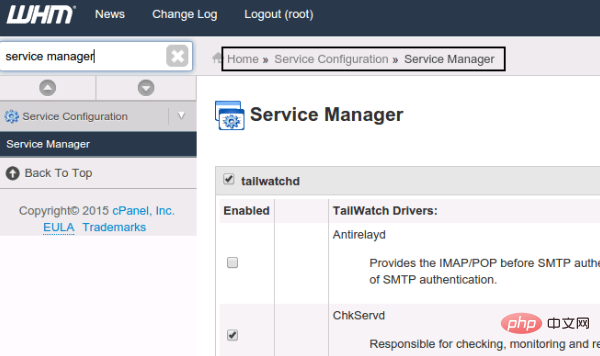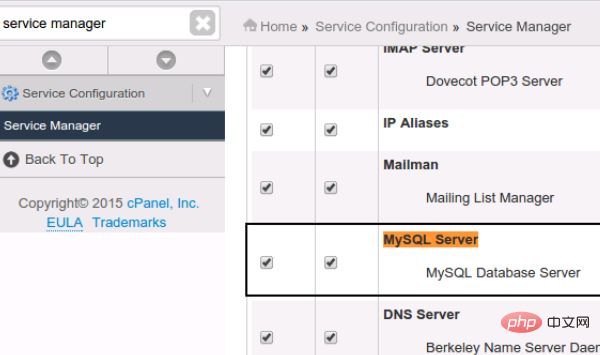How to start mysql
MySQL is the most popular open source SQL database management system and a relational database management system. Relational databases store data in different tables. This article will introduce to you, How to start or stop the MySQL service on Windows and Linux systems.

Recommended learning reference: "mysql tutorial"
1. Windows mysql startup
1. Find the computer icon on the desktop, right-click the mouse, and open management tools->Services, as shown below.


2. In the services window, find and select the MySQL service.
If the MySQL service is running, you will see the following 3 options next to it.
Stop Service: This option will stop the selected service.
Pause service: This option will pause the selected service.
Restart Service: This option will restart the selected service.

To stop, pause or restart a service, just click on the corresponding option.
3. If mysql is not enabled in the service, which means that the MySQL service is originally stopped, you will only get the start service option, then you only need Just click Start.
4. By performing the above steps, you can also stop/start other Windows services.
2. Linux mysql startup
In Linux VPS, you can stop/start the MySQL service through SSH or WHM control panel.
Stop/Start MySQL Service via SSH/Terminal
Connect to the VPS via SSH using the root user and type the following commands.
Stop MySQL service mysql stop OR /etc/init.d/mysql stop Start MySQL service mysql start OR /etc/init.d/mysql start Restart MySQL service mysql restart OR /etc/init.d/mysql restart Check MySQL server status service mysql status
If you want to stop/start other Linux VPS services, you can use the above command by putting the service name. Here are some of the most common Linux VPS services.
exim // Mail 服务 httpd // Apache Web 服务 named // DNS 服务 sshd // SSH 服务 ftpd // FTP 服务
Start/stop the MySQL service through WHM
1. Log in to WHM (https://your-IP-address:2087).
2. Under the Service Configuration section, select Service Manager.

#3. Uncheck the checkbox under mysql and click the Save button. This will stop the MySQL service.

#4. To start the MySQL service, you just need to check the checkbox under the mysql and Save buttons.
5.Follow the above steps, you can also stop/start other listed services.
This article is about the steps to start the mysql service on Windows and Linux systems. I hope it will be helpful to friends in need!
The above is the detailed content of How to start mysql. For more information, please follow other related articles on the PHP Chinese website!

Hot AI Tools

Undresser.AI Undress
AI-powered app for creating realistic nude photos

AI Clothes Remover
Online AI tool for removing clothes from photos.

Undress AI Tool
Undress images for free

Clothoff.io
AI clothes remover

AI Hentai Generator
Generate AI Hentai for free.

Hot Article

Hot Tools

Notepad++7.3.1
Easy-to-use and free code editor

SublimeText3 Chinese version
Chinese version, very easy to use

Zend Studio 13.0.1
Powerful PHP integrated development environment

Dreamweaver CS6
Visual web development tools

SublimeText3 Mac version
God-level code editing software (SublimeText3)

Hot Topics
 How do you alter a table in MySQL using the ALTER TABLE statement?
Mar 19, 2025 pm 03:51 PM
How do you alter a table in MySQL using the ALTER TABLE statement?
Mar 19, 2025 pm 03:51 PM
The article discusses using MySQL's ALTER TABLE statement to modify tables, including adding/dropping columns, renaming tables/columns, and changing column data types.
 How do I configure SSL/TLS encryption for MySQL connections?
Mar 18, 2025 pm 12:01 PM
How do I configure SSL/TLS encryption for MySQL connections?
Mar 18, 2025 pm 12:01 PM
Article discusses configuring SSL/TLS encryption for MySQL, including certificate generation and verification. Main issue is using self-signed certificates' security implications.[Character count: 159]
 How do you handle large datasets in MySQL?
Mar 21, 2025 pm 12:15 PM
How do you handle large datasets in MySQL?
Mar 21, 2025 pm 12:15 PM
Article discusses strategies for handling large datasets in MySQL, including partitioning, sharding, indexing, and query optimization.
 What are some popular MySQL GUI tools (e.g., MySQL Workbench, phpMyAdmin)?
Mar 21, 2025 pm 06:28 PM
What are some popular MySQL GUI tools (e.g., MySQL Workbench, phpMyAdmin)?
Mar 21, 2025 pm 06:28 PM
Article discusses popular MySQL GUI tools like MySQL Workbench and phpMyAdmin, comparing their features and suitability for beginners and advanced users.[159 characters]
 How do you drop a table in MySQL using the DROP TABLE statement?
Mar 19, 2025 pm 03:52 PM
How do you drop a table in MySQL using the DROP TABLE statement?
Mar 19, 2025 pm 03:52 PM
The article discusses dropping tables in MySQL using the DROP TABLE statement, emphasizing precautions and risks. It highlights that the action is irreversible without backups, detailing recovery methods and potential production environment hazards.
 How do you represent relationships using foreign keys?
Mar 19, 2025 pm 03:48 PM
How do you represent relationships using foreign keys?
Mar 19, 2025 pm 03:48 PM
Article discusses using foreign keys to represent relationships in databases, focusing on best practices, data integrity, and common pitfalls to avoid.
 How do you create indexes on JSON columns?
Mar 21, 2025 pm 12:13 PM
How do you create indexes on JSON columns?
Mar 21, 2025 pm 12:13 PM
The article discusses creating indexes on JSON columns in various databases like PostgreSQL, MySQL, and MongoDB to enhance query performance. It explains the syntax and benefits of indexing specific JSON paths, and lists supported database systems.
 How do I secure MySQL against common vulnerabilities (SQL injection, brute-force attacks)?
Mar 18, 2025 pm 12:00 PM
How do I secure MySQL against common vulnerabilities (SQL injection, brute-force attacks)?
Mar 18, 2025 pm 12:00 PM
Article discusses securing MySQL against SQL injection and brute-force attacks using prepared statements, input validation, and strong password policies.(159 characters)






